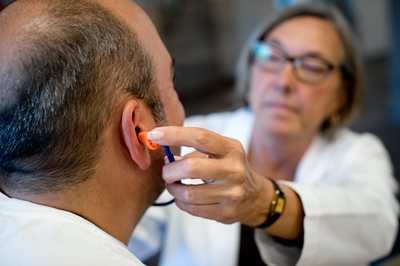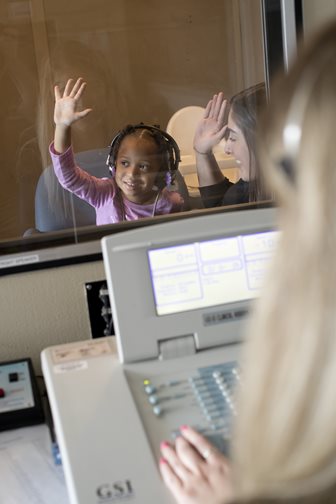With hearing and balance disorders increasing as our population ages, audiology has become one of the fastest growing professions in the country. With an expected growth rate of 29 percent from 2014 through 2024, as projected by the Bureau of Labor Statistics, and an average salary of $75,980, there is no better time to become an audiologist.
 As a healthcare professional focused on the science of hearing- and balance-related disorders, an audiologist identifies, diagnoses and treats auditory and vestibular conditions in both children and adults. Audiologists work to improve their patients’ quality of life based on their diagnosis, and take a holistic approach when treating the patient from a medical, psychological, physical, social and educational perspective. Pediatric and educational audiologists work with children, enhancing their academic gains as well as assessing childhood milestones.
As a healthcare professional focused on the science of hearing- and balance-related disorders, an audiologist identifies, diagnoses and treats auditory and vestibular conditions in both children and adults. Audiologists work to improve their patients’ quality of life based on their diagnosis, and take a holistic approach when treating the patient from a medical, psychological, physical, social and educational perspective. Pediatric and educational audiologists work with children, enhancing their academic gains as well as assessing childhood milestones.
Audiologists prescribe amplification devices such as hearing aids, cochlear implants, assistive listening systems, and other implantable devices that can help patients in a variety of listening situations and environments. They also provide personalized fitting appointments for amplification tools and counsel patients on their proper use. On-going support such as cleaning patients’ devices and checking them to ensure they’re working properly is also typical.
Hearing conservation is another important aspect of an audiologist’s job. They work with individuals in noisy industries such as music, construction and labor, and fit them with customized ear plugs and other protective hearing devices.
Audiologists work with people of all ages from infants to the elderly in a variety of settings including hospitals, Ear Nose and Throat (ENT) Specialist offices, schools, and private practices.
Many times, they can be found working in a team alongside other professionals such as speech-language pathologists, occupational therapists, physical therapists, teachers and parents. They oversee trouble-shooting the technology used daily by many individuals at home and in the classroom. Audiologists may also be found in balance centers assessing vestibular disorders and working alongside physical therapists.
In order to practice as a professional, audiologists must attain their Doctor of Audiology degree (AuD) and become licensed in the individual state in which they are practicing. They can also earn a Certificate of Clinical Competence in Audiology (CCC-A) from the American Speech-Language-Hearing Association to further enhance their credentials.
 Salus University is the first and only stand-alone College of Audiology in the United States. Students enter the University’s Osborne College of Audiology (OCA) from a variety of undergraduate backgrounds, enhancing student learning in a diverse environment. During their time at Salus, students develop skills through supervised clinical hours on campus at the Pennsylvania Ear Institute (PEI) as well as through off-campus externships. Graduates of OCA leave with more than 2,500 clinical hours in patient care settings ranging from pediatrics to elderly populations, useful practice management training, and exceptional patient care skills.
Salus University is the first and only stand-alone College of Audiology in the United States. Students enter the University’s Osborne College of Audiology (OCA) from a variety of undergraduate backgrounds, enhancing student learning in a diverse environment. During their time at Salus, students develop skills through supervised clinical hours on campus at the Pennsylvania Ear Institute (PEI) as well as through off-campus externships. Graduates of OCA leave with more than 2,500 clinical hours in patient care settings ranging from pediatrics to elderly populations, useful practice management training, and exceptional patient care skills.
Beyond educating students on the assessment and treatment of hearing-related issues, OCA covers the entire spectrum of audiological and vestibular health. Students are provided with the opportunity to combine patient care with modern technology through the availability of extensive laboratory equipment on site. On-campus students are exposed to hearing aid, audiological, electrophysiological, and vestibular clinical diagnostic equipment through the combination of both lecture and laboratory coursework. The University’s vestibular lab includes full videonystagmography and electronystagmography stations as well as posturography and one of fewer than 100 existing rotary chairs in the entire country. Utilized for vestibular rehabilitation, the rotary chair is also used in the advance diagnostics of balance disorders.
A Salus University Osborne College of Audiology education goes beyond the Elkins Park campus and extends worldwide. The Doctor of Audiology Online Bridge Program is a distance education, international degree program offered online for working audiologists with a master’s degree or medical degree in audiology. This online program is uniquely designed to meet the educational needs of the practicing audiologist. The profession of audiology worldwide is distinct in that it is a multi-disciplinary area of study and practice. The University’s online audiology bridge program is a great way for practicing audiologists committed to remain current with today’s rapid advances in audiology and the health sciences. More information about the bridge program from a graduate.